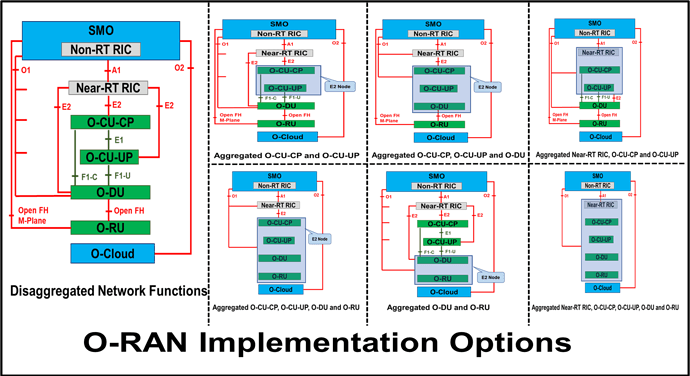-
My friend: Hi Ibrahim, I have a question for you.
- Me: Please, go ahead.
-
My friend: I was wondering what are the different options to implement Open RAN network?
- Me: Actually, O-RAN Alliance proposed different options to implement Open RAN networks. So, although the well-known O-RAN architecture is to have all nodes disaggregated, we still have some options where some nodes are combined and so some interfaces are removed.
-
My friend: Really, could you give some examples?
- Me: O-RAN Alliance proposed different options, where the 1st option is all nodes are disaggregated, but other options exist such as combining both the O-CU-CP and O-CU-UP into one node that can be implemented by one vendor. Also, we can aggregate the O-CU-CP, O-CU-UP and O-DU together into one node. Moreover, we can integrate the Near-RT RIC, O-CU-CP and O-CU-UP together into one node. Furthermore, we can merge the O-CU-CP, O-CU-UP, O-DU and O-RU together into one node. Then, it is possible to combine the O-DU and O-RU into one node and lastly, we can aggregate the Near-RT RIC, O-CU-CP, O-CU-UP, O-DU and O-RU into one node. Please check the below graph for the full illustration.
-
My friend: But why do we have different options for implementation?
- Me: In the specifications, usually, all the possible options should be listed to provide high flexibility in the implementation of Open RAN networks. Then, it depends on the vendors and their decision about which nodes will be aggregated together. Also, this will add some complexity to both O1 and E2 interfaces as both interfaces should be able to detect which option is used and encapsulate specific messages for internal nodes such as O-DU only.
-
My friend: Thank you so much. You made it very clear.
- Me: You are most welcome.
Linkedin: Ibrahim Sayed, PMP on LinkedIn: #5g #5gnr #openran | 14 comments
